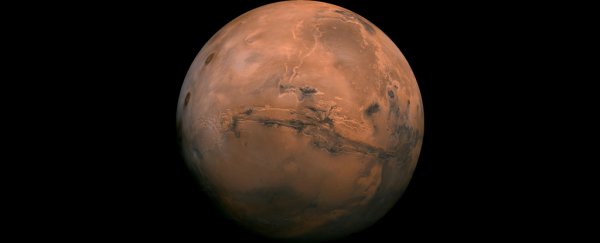Mars is the fourth planet that orbits the Sun in our Solar System. Circling at an average distance of approximately 229 million kilometres (around 142 million miles) from the Sun, it sits between the orbits of Earth and Jupiter.
The planet is a terrestrial or 'rocky' body with complex geological characteristics and even signs that liquid water, if not glaciers, have at some point eroded its surface.
Despite many similarities between Earth and Mars, Mars has had a significantly different history to our own planet.
Known as the 'Red Planet', Mars' rust-coloured appearance really sets it apart, and that might have something to do with its smaller size.
The planet has roughly one-tenth of our own planet's mass and about half of its diameter.
Less mass means a weaker gravitational force to draw heavy elements into its core, which goes some way towards explaining why there appears to be relatively high concentrations of iron in its crust.
Rusted into iron oxide, this abundance of metal turns the landscape a dull orange colour.
Another difference to Earth, is that Mars is no longer as geologically dynamic, thanks to a more rapid cooling of its molten insides.
Not only does this mean it no longer has volcanic activity, the planet's core is likely to be far less mobile, depriving it of a magnetic field that would protect its atmosphere from the eroding effects of solar wind.
Over millions of years, the Sun's radiation has stripped away a large fraction of carbon dioxide and water gases, leaving Mars' atmosphere 100 times thinner than our own. It's thought that the stripping of Mars' atmosphere played a crucial role in drying the planet out.
As a result of this thin blanket of gases and distance from the Sun, Mars is a relatively cold planet with global temperatures averaging around minus 60 degrees Celsius (minus 80 Fahrenheit).
Is there life on Mars?
Based on the balance of data provided by centuries of star gazing and dozens of robotic expeditions, there is no hard evidence that life has ever flourished on the Martian surface.
But this could change with discoveries made by future expeditions.
For life, as we understand it, to persist, there needs to be some kind of complex chemistry, a fluid solvent - such as liquid water - to support reactions between the materials, and a source of energy to drive the whole process.
On the flip side, it's preferable that there are no destructive forces to get in the way, such as intense radiation or corrosive agents.
There is a strong likelihood that the surface of Mars has similar kinds of carbon-based compounds that are associated with life and its origins on Earth.
It has almost certainly had liquid water flowing intermittently across its surface at some point in the past, and still could contain temporary or enduring reservoirs in some areas.
As for energy, Mars receives less than half as much sunlight as we do on Earth. Still, it's far from a dimly lit world, so photosynthesising life could exist on its surface.
That's the good news.
Unfortunately, concentrations of highly destructive compounds in the Martian crust and in its water would make life as we know it unlikely to get a foothold. Considering there is no magnetic field and only a thin atmosphere to shield radiation, life-sustaining chemistry on the surface is looking unlikely.
Could it persist deeper underground? Perhaps. But it's going to take some digging to find it.
All Explainers are determined by fact checkers to be correct and relevant at the time of publishing. Text and images may be altered, removed, or added to as an editorial decision to keep information current.
